What Are the Predatory Defense Mechanisms of Chinchillas?

Chinchillas have evolved several defense mechanisms to protect themselves from predators. These tactics include their excellent jumping ability, which allows them to escape quickly and easily. Chinchillas also have a keen sense of hearing and can detect predators from a distance. In addition, chinchillas have dense fur that helps them blend into their surroundings, making it difficult for predators to spot them. Overall, chinchillas have developed a range of strategic tactics to stay safe in the wild.
Understanding these defense mechanisms can help us appreciate the unique adaptations of chinchillas and the challenges they face in their natural habitat. By studying their behaviors and strategies, we can gain insights into how these small rodents have survived and thrived in the wild for centuries.
Agility and Speed

Chinchillas rely on their remarkable agility and speed to evade predators in their natural habitat. Their survival instincts are finely tuned, with quick reflexes allowing them to react swiftly to impending danger. When faced with a threat, chinchillas showcase impressive acceleration and dodging techniques to outmaneuver their predators.
These small rodents possess a keen sense of awareness, enabling them to detect predators quickly. Once a threat is identified, chinchillas spring into action, utilizing their agility to swiftly change direction and evade capture. Their ability to navigate through rocky terrains and dense vegetation with ease further enhances their chances of survival.
In the face of danger, chinchillas exhibit remarkable speed, darting and zigzagging to confuse predators and avoid being caught. This combination of quick reflexes, acceleration, and dodging skills showcases the agility that chinchillas have honed over generations to outwit their natural foes.
Sharp Incisors for Defense
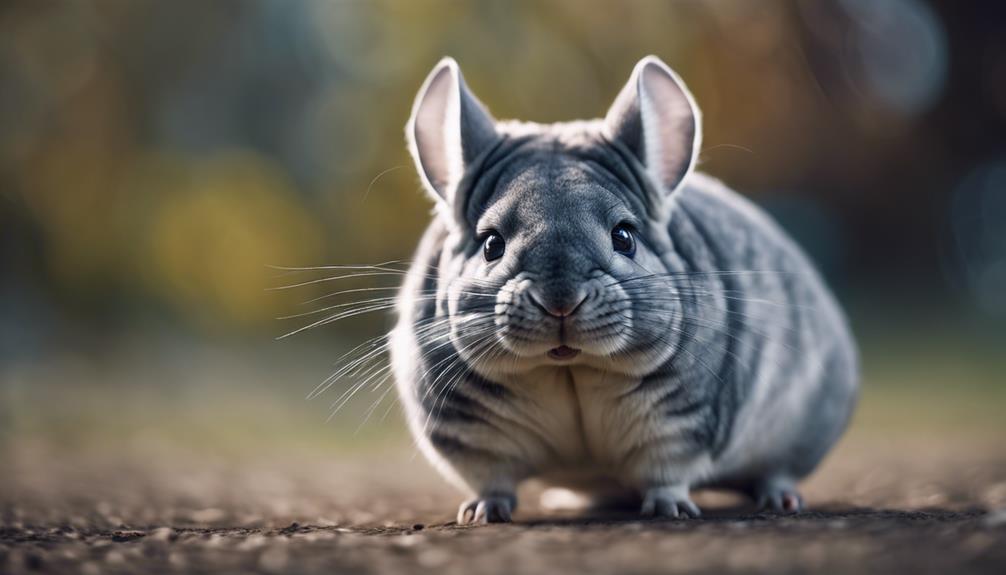
Chinchillas possess formidable defense mechanisms, with their sharp incisors being a key feature in their arsenal. These rodents have continuously growing front teeth that are razor-sharp, enabling them to inflict serious injuries when threatened.
When cornered or in danger, chinchillas can exhibit aggressive biting behavior, making good use of their powerful jaws and sharp incisors for protection.
Tooth Structure
With sharp incisors specially adapted for defense, chinchillas possess a formidable tooth structure that aids in their predatory defense mechanisms. These incisors are crucial for maintaining dental hygiene and supporting their unique chewing habits. Chinchillas' teeth grow continuously, and their chewing behavior helps wear down these teeth to prevent overgrowth. This evolutionary advantage ensures that their incisors remain sharp and ready for defense.
The dental structure of chinchillas is designed to withstand the rigors of their natural habitat and predatory instincts. By having strong, sharp incisors, chinchillas can effectively defend themselves against potential threats. Understanding the importance of their tooth structure sheds light on how chinchillas utilize this feature as part of their overall defense mechanisms.
Aggressive Biting Behavior
Their sharp incisors not only aid in maintaining dental hygiene but also serve as a crucial component of chinchillas' aggressive biting behavior, enhancing their predatory defense mechanisms.
When dealing with chinchillas displaying aggressive biting behavior, understanding the triggers and implementing preventive measures is essential. Here are some key points to consider:
- Behavioral Triggers: Identify what stimuli provoke aggressive biting in chinchillas.
- Prevention Techniques: Implement strategies to avoid situations that may lead to aggressive behavior.
- Handling Techniques: Properly hold and interact with your chinchilla to reduce the likelihood of aggressive biting.
- Training Techniques: Use positive reinforcement methods to train chinchillas to curb aggressive tendencies effectively.
Camouflage Adaptations
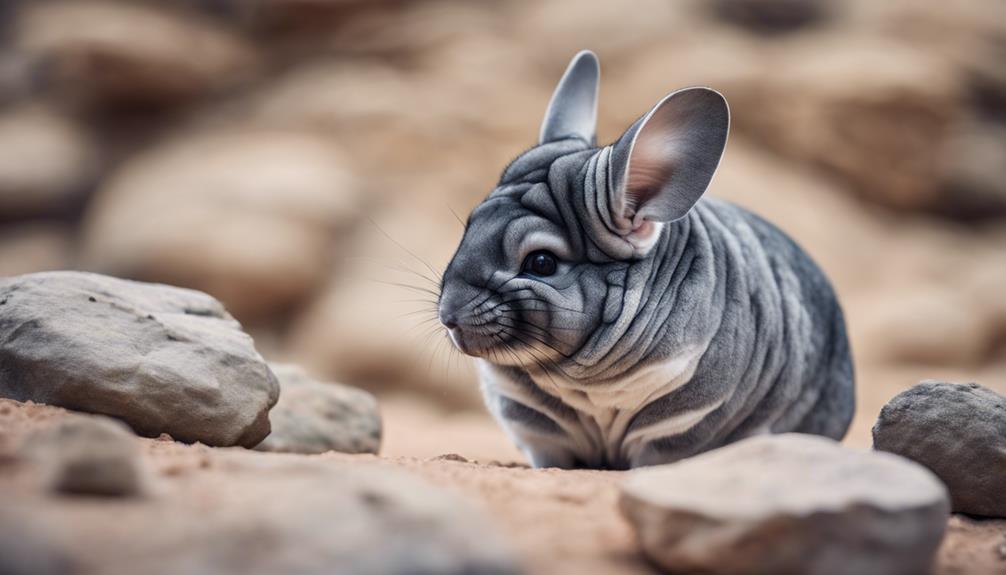
In their natural habitat, chinchillas employ highly effective camouflage adaptations to evade predators. These small rodents have remarkable color-changing abilities that help them blend seamlessly into their surroundings, making it challenging for predators to spot them. Chinchillas possess dense fur that comes in various shades of gray, beige, and brown, allowing them to match the colors of the rocks and shrubs in their environment. This coloration not only aids in predator avoidance but also enables chinchillas to remain hidden while foraging for food or resting.
Furthermore, chinchillas have adapted to have a fur texture that mimics the appearance of the rocky terrain they inhabit. Their fur is thick and soft, resembling the texture of the rocks, which adds an extra layer of disguise against potential threats. By utilizing both their color-changing abilities and fur texture, chinchillas have evolved effective camouflage mechanisms that serve as a crucial defense strategy in the wild.
Vocal Warning Signals
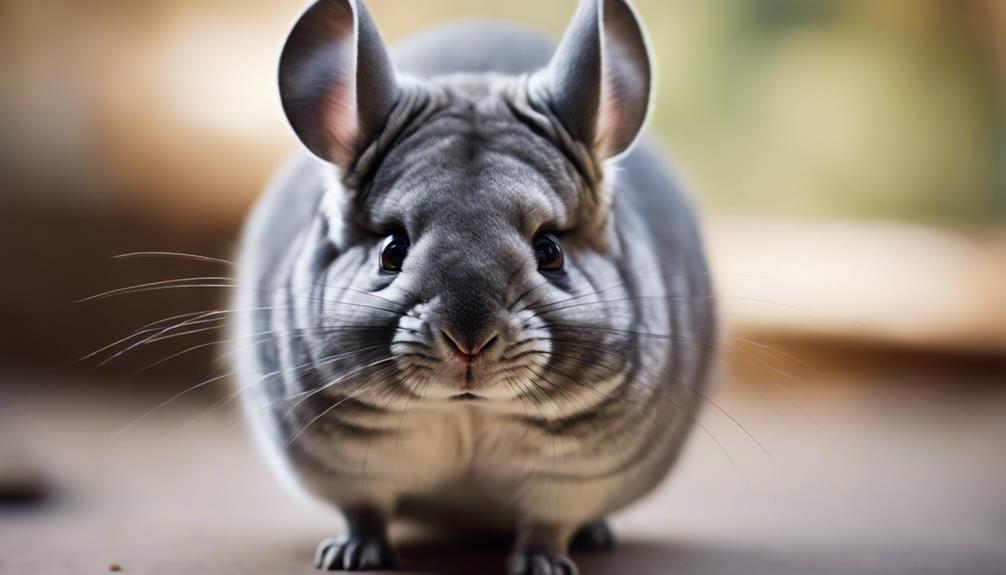
Chinchillas communicate potential danger to their group members through a series of distinct vocal warning signals. These signals play a crucial role in alerting others to potential threats, helping the group stay safe in their habitat.
Here are some key aspects of chinchillas' vocal warning signals:
- Varied Calls: Chinchillas use a range of vocalizations to communicate different levels of danger. High-pitched calls may indicate immediate threats, while lower, softer sounds could signal a less urgent situation.
- Communication Methods: Chinchillas not only use vocalizations but also rely on body language to enhance the effectiveness of their warnings. This can include aggressive postures or sudden movements to alert others.
- Group Response: When one chinchilla detects danger and vocalizes a warning, the rest of the group typically responds by freezing or fleeing to safety, showing the effectiveness of these signals in coordinating group defense.
- Predatory Behavior and Scent Marking: Chinchillas' vocal warnings are often accompanied by scent marking, where they release pheromones to further communicate danger and mark their territory, creating a multi-layered defense strategy.
Escaping Predators Through Burrows
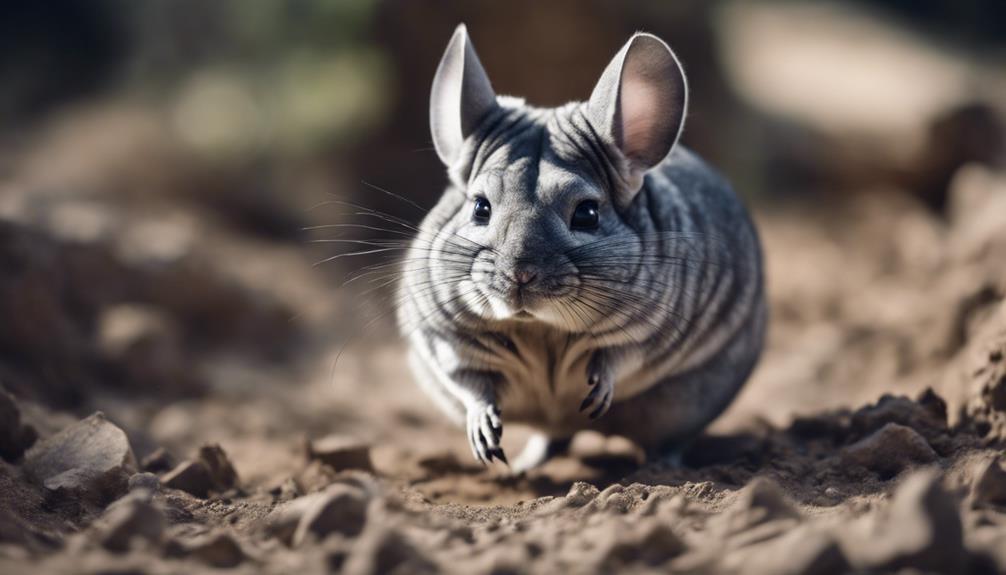
Chinchillas have an innate ability to construct intricate burrows as a means of escaping predators. These burrows are meticulously designed to provide safety and protection from potential threats.
Understanding the construction techniques and safety benefits of these burrows sheds light on the remarkable predatory defense mechanisms of chinchillas.
Burrow Construction Techniques
Utilizing their specialized claws and keen sense of spatial awareness, chinchillas expertly construct intricate burrows as a means of evading predators in their natural habitats. These tunneling techniques and underground escape routes allow chinchillas to effectively avoid danger and predators in the wild. Here are four key aspects of chinchilla burrow construction:
- Depth: Chinchillas dig their burrows deep into the ground, creating multiple levels to confuse predators.
- Entrance Design: The entrance to a chinchilla burrow is often narrow and well-hidden, making it difficult for predators to access.
- Tunneling Patterns: Chinchillas create intricate tunneling patterns within their burrows, including dead-ends and sharp turns, to deter predators.
- Emergency Exits: Chinchillas construct multiple emergency exits within their burrows, providing alternative escape routes in case of danger.
Safety Benefits of Burrows
With their intricate burrow construction, chinchillas gain safety benefits by utilizing these underground structures as a means to escape predators efficiently.
The burrow architecture of chinchillas serves as a crucial mechanism for predatory evasion. These small mammals dig complex systems of tunnels that provide them with a safe retreat when threatened by predators such as foxes, birds of prey, and snakes.
By quickly darting into their burrows, chinchillas can outmaneuver predators that may be larger and faster than them. The narrow and intricate passages of their burrows make it challenging for predators to follow, giving chinchillas a strategic advantage in evading capture.
This instinctual behavior showcases how chinchillas have adapted to their environment to ensure their survival in the face of danger.
Social Group Defense Strategies

In response to threats, social groups of chinchillas demonstrate coordinated defense strategies to ensure collective safety and survival. Chinchillas rely on their group dynamics and predatory instincts to ward off potential dangers effectively.
- Strength in Numbers: Chinchillas understand that there's safety in sticking together as a group. When faced with predators, they huddle close, presenting a more formidable front to potential threats.
- Alarm Calls: Chinchillas have a complex system of alarm calls to alert others in the group of approaching danger. This communication helps in coordinating group responses and evasive actions.
- Shared Vigilance: Members of the chinchilla social group take turns keeping watch for predators while others feed or rest. This shared vigilance ensures that potential threats are spotted early, allowing the group to react swiftly.
- Collective Defense Tactics: In the face of imminent danger, chinchillas work together to confuse predators, scatter in different directions, and regroup later in a safer location. This coordinated defense strategy increases their chances of survival as a group.
Adaptation to Nocturnal Lifestyle
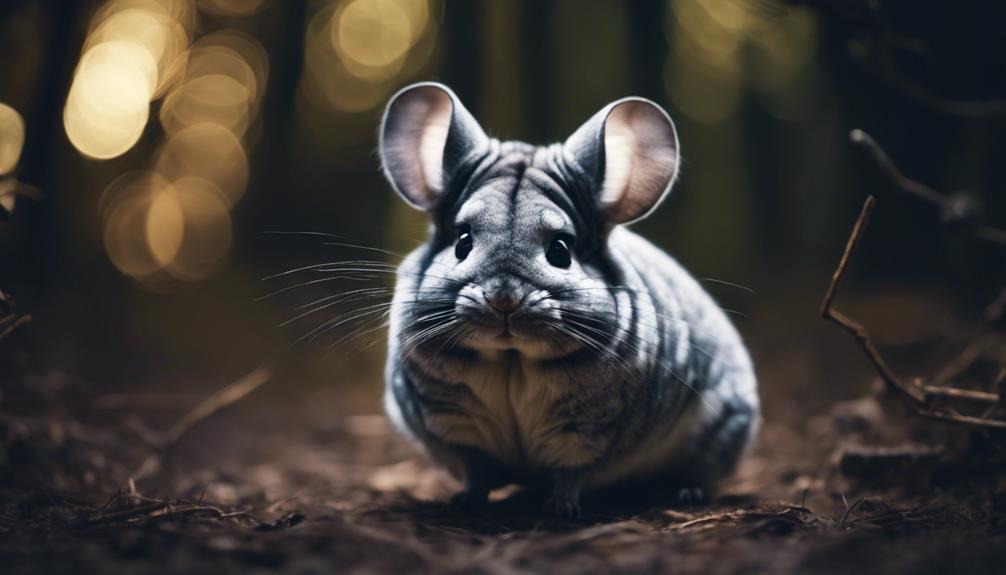
How do chinchillas adapt to their nocturnal lifestyle for survival and efficiency?
Chinchillas have developed remarkable nocturnal adaptations to evade predators and thrive during the night. Their keen senses of hearing and smell allow them to detect predators in the darkness, while their large eyes equipped with tapetum lucidum enhance night vision, aiding in predator evasion.
Chinchillas are crepuscular, meaning they're most active during dawn and dusk, which helps them avoid predators that are more active during the day or night. By being active during low-light periods, chinchillas increase their chances of survival by minimizing encounters with predators.
Furthermore, their agile and swift movements enable quick escapes from potential threats in the darkness. Through these nocturnal adaptations, chinchillas have honed their abilities to navigate and thrive in their nighttime environment, ensuring their survival and efficiency in evading predators.
Frequently Asked Questions
How Do Chinchillas Communicate With Each Other Within Their Social Groups?
Chinchillas communicate within social groups through vocal signals, grooming behaviors, scent marking, and body language. They use a variety of cues to convey messages and maintain social bonds, ensuring effective communication and group cohesion.
Are There Any Natural Predators of Chinchillas in the Wild?
Ironically, one might think chinchillas, with their cute appearance, don't face threats. However, in the wild, they encounter predators like birds of prey, foxes, and snakes. Chinchillas survive through agility and hiding.
Can Chinchillas Swim to Escape Predators?
Chinchillas rely on their predatory instincts and escape tactics rather than swimming to evade predators. Their survival strategies involve agility and speed on land, using their excellent jumping abilities and camouflage to avoid threats efficiently.
Do Chinchillas Have Any Specific Adaptations to Protect Themselves From Aerial Predators?
When facing aerial predators, chinchillas rely on their natural camouflage techniques, blending into their surroundings like shadows in the night. Swift evading maneuvers help them escape danger, disappearing into the landscape with grace and stealth.
How Do Chinchillas Mark Their Territory to Avoid Conflicts With Other Chinchilla Groups?
Chinchillas utilize scent marking as a crucial part of their social behavior to delineate territory boundaries and avoid conflicts with other chinchilla groups. This behavior helps maintain order and establish clear communication within their community.











